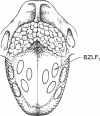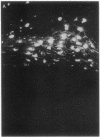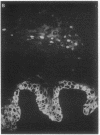Abstract
The Epstein-Barr virus (EBV) immediate early gene product BZLF1 was localized by indirect immunofluorescence to the cytoplasm of the basal epithelial layer at the lateral border and dorsum of tongue in human immunodeficiency virus-infected and -seronegative patients. Two biopsies of oral hairy leukoplakia revealed a sporadic cytoplasmic staining of the BHRF1 and BRLF1 gene products in the basal epithelial layer. The widespread presence of BZLF1 in the basal epithelial layer indicated that this cell layer contained EBV DNA and was probably directly infected by EBV. Nuclear localization of the immediate early and early gene products BZLF1, BHRF1, BRLF1, and BMLF1 was limited to oral hairy leukoplakia in human immunodeficiency virus-seropositive patients and revealed a codistribution with the virus capsid antigen. Our results indicate that the epithelium of the tongue is a potential reservoir for EBV and that in heavily immunocompromised patients EBV may move from the cytoplasm to the nucleus with increasing differentiation and be coactivated there during the terminal differentiation of epithelial cells at the lateral border and dorsum of tongue.
Full text
PDF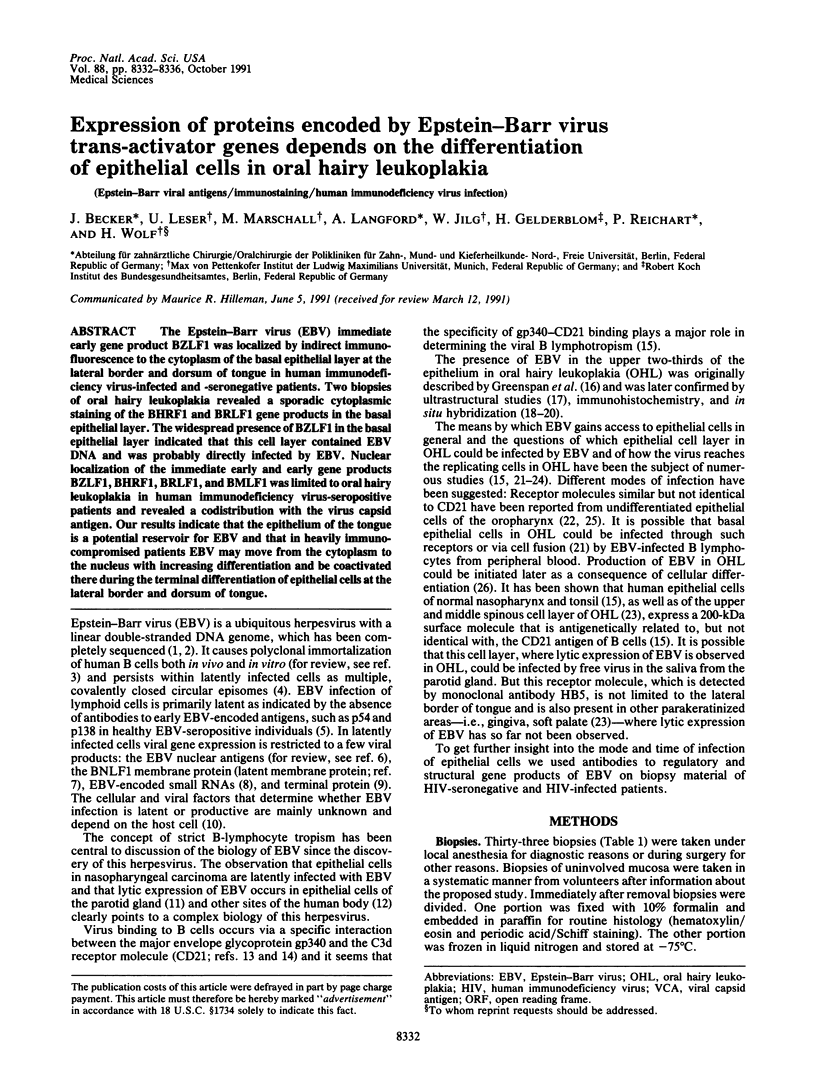
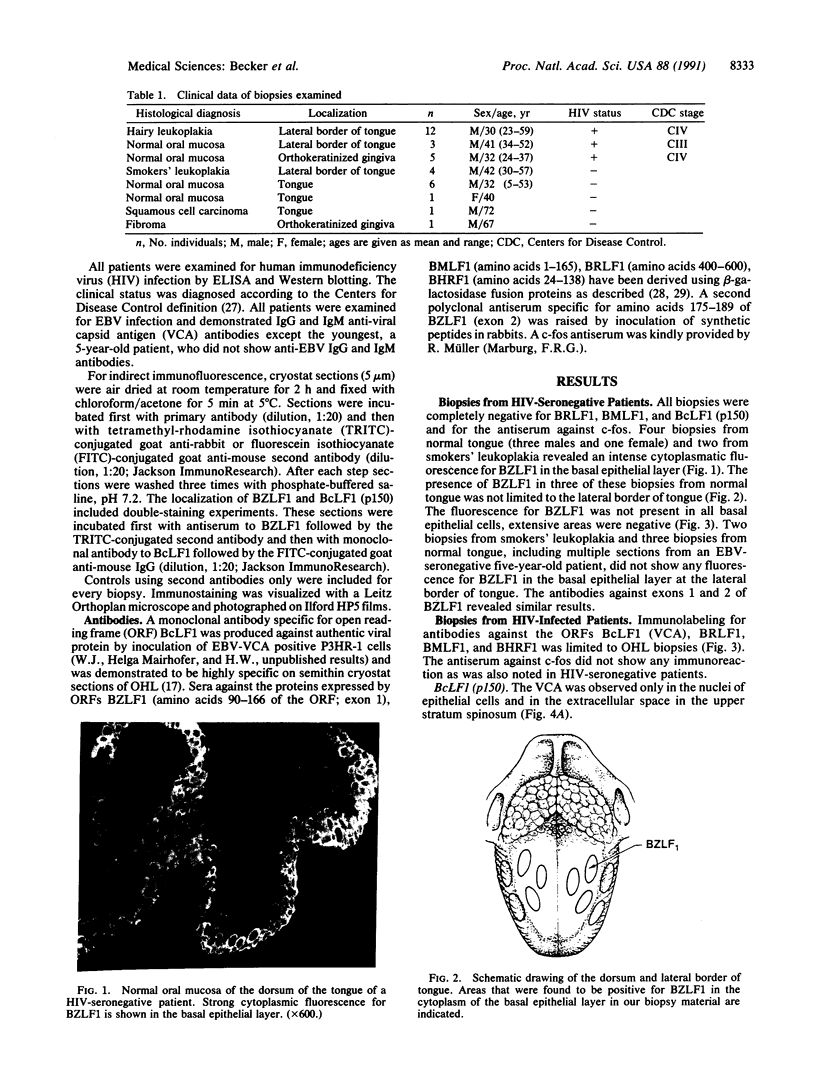
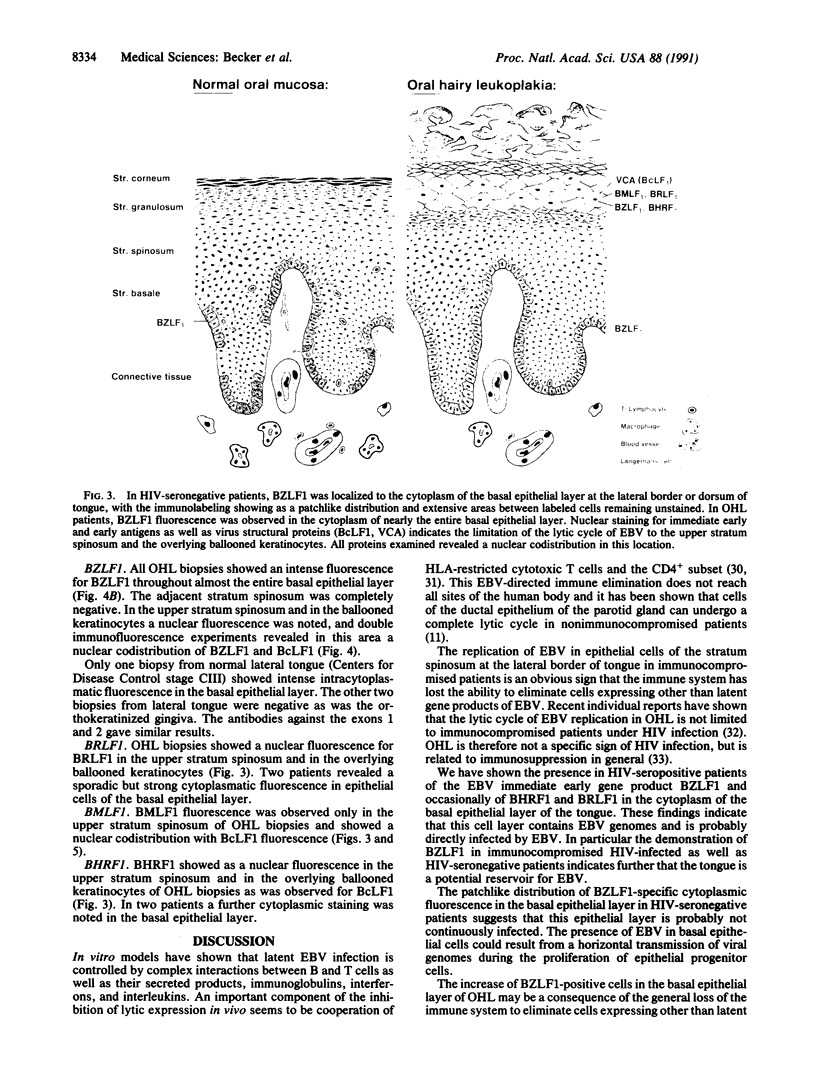
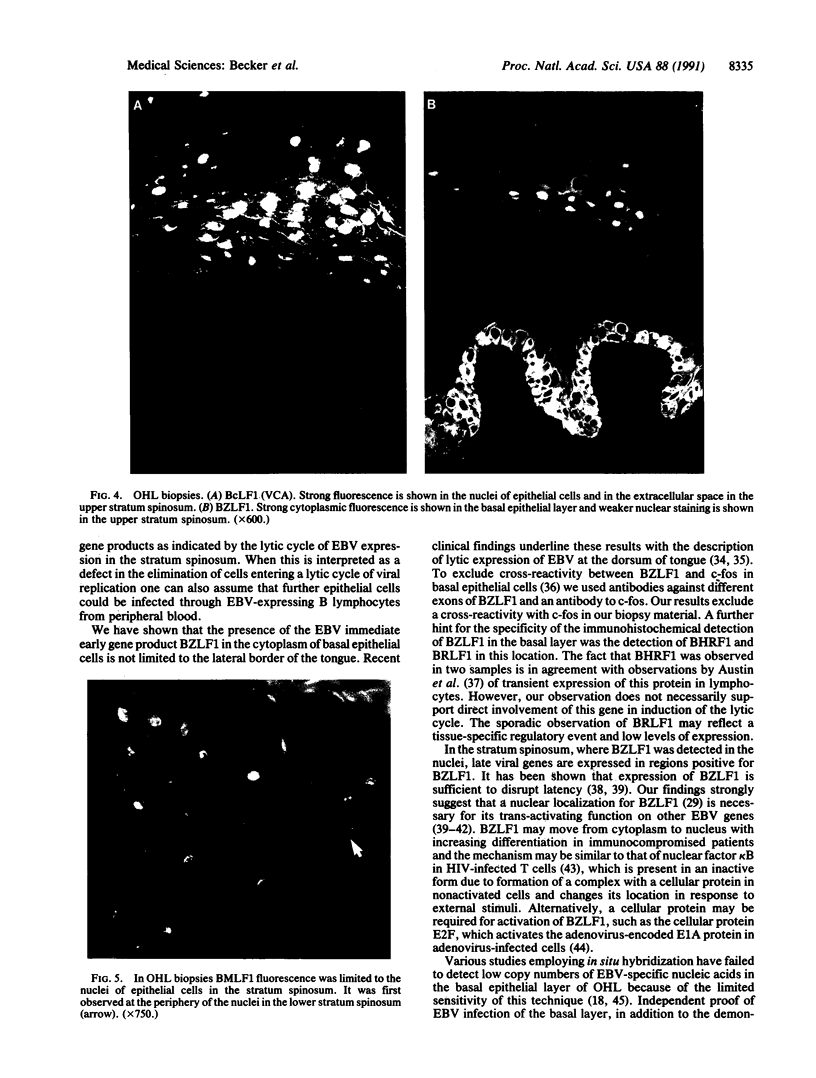
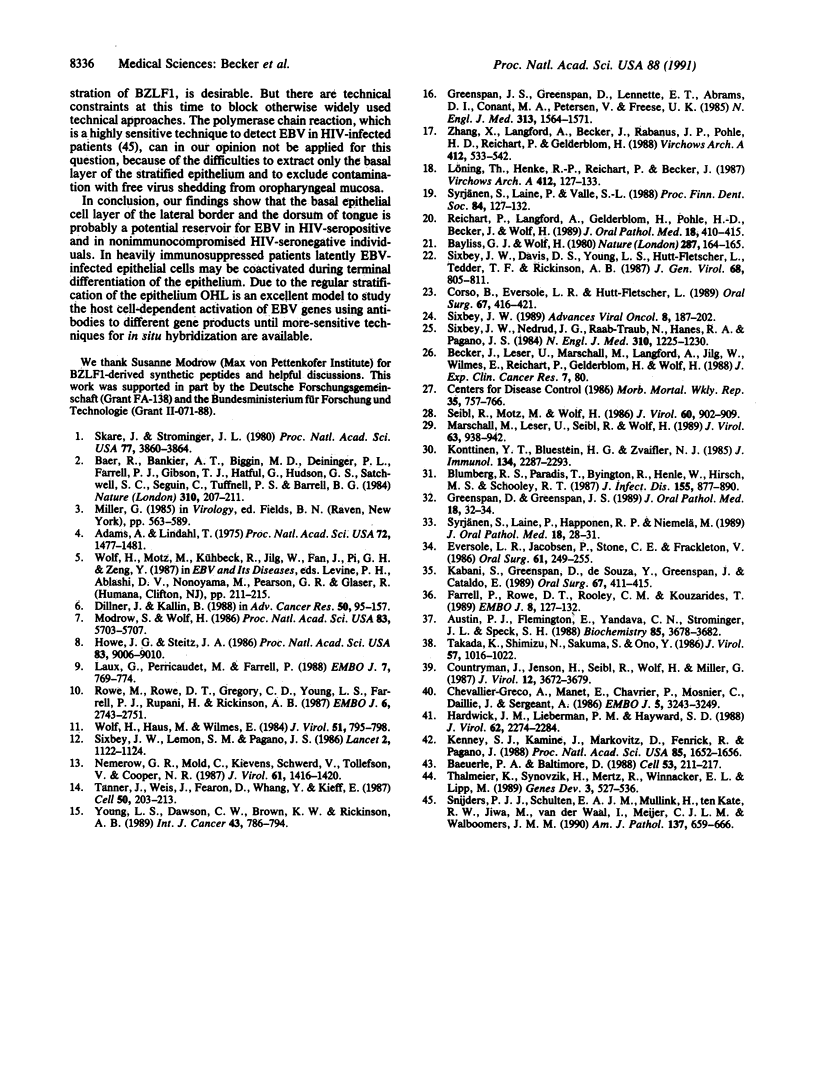
Images in this article
Selected References
These references are in PubMed. This may not be the complete list of references from this article.
- Adams A., Lindahl T. Epstein-Barr virus genomes with properties of circular DNA molecules in carrier cells. Proc Natl Acad Sci U S A. 1975 Apr;72(4):1477–1481. doi: 10.1073/pnas.72.4.1477. [DOI] [PMC free article] [PubMed] [Google Scholar]
- Austin P. J., Flemington E., Yandava C. N., Strominger J. L., Speck S. H. Complex transcription of the Epstein-Barr virus BamHI fragment H rightward open reading frame 1 (BHRF1) in latently and lytically infected B lymphocytes. Proc Natl Acad Sci U S A. 1988 Jun;85(11):3678–3682. doi: 10.1073/pnas.85.11.3678. [DOI] [PMC free article] [PubMed] [Google Scholar]
- Baer R., Bankier A. T., Biggin M. D., Deininger P. L., Farrell P. J., Gibson T. J., Hatfull G., Hudson G. S., Satchwell S. C., Séguin C. DNA sequence and expression of the B95-8 Epstein-Barr virus genome. Nature. 1984 Jul 19;310(5974):207–211. doi: 10.1038/310207a0. [DOI] [PubMed] [Google Scholar]
- Baeuerle P. A., Baltimore D. Activation of DNA-binding activity in an apparently cytoplasmic precursor of the NF-kappa B transcription factor. Cell. 1988 Apr 22;53(2):211–217. doi: 10.1016/0092-8674(88)90382-0. [DOI] [PubMed] [Google Scholar]
- Bayliss G. J., Wolf H. Epstein--Barr virus-induced cell fusion. Nature. 1980 Sep 11;287(5778):164–165. doi: 10.1038/287164a0. [DOI] [PubMed] [Google Scholar]
- Blumberg R. S., Paradis T., Byington R., Henle W., Hirsch M. S., Schooley R. T. Effects of human immunodeficiency virus on the cellular immune response to Epstein-Barr virus in homosexual men: characterization of the cytotoxic response and lymphokine production. J Infect Dis. 1987 May;155(5):877–890. doi: 10.1093/infdis/155.5.877. [DOI] [PubMed] [Google Scholar]
- Centers for Disease Control (CDC) Update: acquired immunodeficiency syndrome--United States. MMWR Morb Mortal Wkly Rep. 1986 Dec 12;35(49):757-60, 765-6. [PubMed] [Google Scholar]
- Chevallier-Greco A., Manet E., Chavrier P., Mosnier C., Daillie J., Sergeant A. Both Epstein-Barr virus (EBV)-encoded trans-acting factors, EB1 and EB2, are required to activate transcription from an EBV early promoter. EMBO J. 1986 Dec 1;5(12):3243–3249. doi: 10.1002/j.1460-2075.1986.tb04635.x. [DOI] [PMC free article] [PubMed] [Google Scholar]
- Corso B., Eversole L. R., Hutt-Fletcher L. Hairy leukoplakia: Epstein-Barr virus receptors on oral keratinocyte plasma membranes. Oral Surg Oral Med Oral Pathol. 1989 Apr;67(4):416–421. doi: 10.1016/0030-4220(89)90384-8. [DOI] [PubMed] [Google Scholar]
- Countryman J., Jenson H., Seibl R., Wolf H., Miller G. Polymorphic proteins encoded within BZLF1 of defective and standard Epstein-Barr viruses disrupt latency. J Virol. 1987 Dec;61(12):3672–3679. doi: 10.1128/jvi.61.12.3672-3679.1987. [DOI] [PMC free article] [PubMed] [Google Scholar]
- Eversole L. R., Jacobsen P., Stone C. E., Freckleton V. Oral condyloma planus (hairy leukoplakia) among homosexual men: a clinicopathologic study of thirty-six cases. Oral Surg Oral Med Oral Pathol. 1986 Mar;61(3):249–255. doi: 10.1016/0030-4220(86)90370-1. [DOI] [PubMed] [Google Scholar]
- Farrell P. J., Rowe D. T., Rooney C. M., Kouzarides T. Epstein-Barr virus BZLF1 trans-activator specifically binds to a consensus AP-1 site and is related to c-fos. EMBO J. 1989 Jan;8(1):127–132. doi: 10.1002/j.1460-2075.1989.tb03356.x. [DOI] [PMC free article] [PubMed] [Google Scholar]
- Greenspan D., Greenspan J. S., de Souza Y., Levy J. A., Ungar A. M. Oral hairy leukoplakia in an HIV-negative renal transplant recipient. J Oral Pathol Med. 1989 Jan;18(1):32–34. doi: 10.1111/j.1600-0714.1989.tb00729.x. [DOI] [PubMed] [Google Scholar]
- Greenspan J. S., Greenspan D., Lennette E. T., Abrams D. I., Conant M. A., Petersen V., Freese U. K. Replication of Epstein-Barr virus within the epithelial cells of oral "hairy" leukoplakia, an AIDS-associated lesion. N Engl J Med. 1985 Dec 19;313(25):1564–1571. doi: 10.1056/NEJM198512193132502. [DOI] [PubMed] [Google Scholar]
- Hardwick J. M., Lieberman P. M., Hayward S. D. A new Epstein-Barr virus transactivator, R, induces expression of a cytoplasmic early antigen. J Virol. 1988 Jul;62(7):2274–2284. doi: 10.1128/jvi.62.7.2274-2284.1988. [DOI] [PMC free article] [PubMed] [Google Scholar]
- Howe J. G., Steitz J. A. Localization of Epstein-Barr virus-encoded small RNAs by in situ hybridization. Proc Natl Acad Sci U S A. 1986 Dec;83(23):9006–9010. doi: 10.1073/pnas.83.23.9006. [DOI] [PMC free article] [PubMed] [Google Scholar]
- Kabani S., Greenspan D., deSouza Y., Greenspan J. S., Cataldo E. Oral hairy leukoplakia with extensive oral mucosal involvement. Report of two cases. Oral Surg Oral Med Oral Pathol. 1989 Apr;67(4):411–415. doi: 10.1016/0030-4220(89)90383-6. [DOI] [PubMed] [Google Scholar]
- Kenney S., Kamine J., Markovitz D., Fenrick R., Pagano J. An Epstein-Barr virus immediate-early gene product trans-activates gene expression from the human immunodeficiency virus long terminal repeat. Proc Natl Acad Sci U S A. 1988 Mar;85(5):1652–1656. doi: 10.1073/pnas.85.5.1652. [DOI] [PMC free article] [PubMed] [Google Scholar]
- Konttinen Y. T., Bluestein H. G., Zvaifler N. J. Regulation of the growth of Epstein-Barr virus-infected B cells. I. Growth regression by E rosetting cells from VCA-positive donors is a combined effect of autologous mixed leukocyte reaction and activation of T8+ memory cells. J Immunol. 1985 Apr;134(4):2287–2293. [PubMed] [Google Scholar]
- Laux G., Perricaudet M., Farrell P. J. A spliced Epstein-Barr virus gene expressed in immortalized lymphocytes is created by circularization of the linear viral genome. EMBO J. 1988 Mar;7(3):769–774. doi: 10.1002/j.1460-2075.1988.tb02874.x. [DOI] [PMC free article] [PubMed] [Google Scholar]
- Löning T., Henke R. P., Reichart P., Becker J. In situ hybridization to detect Epstein-Barr virus DNA in oral tissues of HIV-infected patients. Virchows Arch A Pathol Anat Histopathol. 1987;412(2):127–133. doi: 10.1007/BF00716184. [DOI] [PubMed] [Google Scholar]
- Marschall M., Leser U., Seibl R., Wolf H. Identification of proteins encoded by Epstein-Barr virus trans-activator genes. J Virol. 1989 Feb;63(2):938–942. doi: 10.1128/jvi.63.2.938-942.1989. [DOI] [PMC free article] [PubMed] [Google Scholar]
- Modrow S., Wolf H. Characterization of two related Epstein-Barr virus-encoded membrane proteins that are differentially expressed in Burkitt lymphoma and in vitro-transformed cell lines. Proc Natl Acad Sci U S A. 1986 Aug;83(15):5703–5707. doi: 10.1073/pnas.83.15.5703. [DOI] [PMC free article] [PubMed] [Google Scholar]
- Nemerow G. R., Mold C., Schwend V. K., Tollefson V., Cooper N. R. Identification of gp350 as the viral glycoprotein mediating attachment of Epstein-Barr virus (EBV) to the EBV/C3d receptor of B cells: sequence homology of gp350 and C3 complement fragment C3d. J Virol. 1987 May;61(5):1416–1420. doi: 10.1128/jvi.61.5.1416-1420.1987. [DOI] [PMC free article] [PubMed] [Google Scholar]
- Reichart P. A., Langford A., Gelderblom H. R., Pohle H. D., Becker J., Wolf H. Oral hairy leukoplakia: observations in 95 cases and review of the literature. J Oral Pathol Med. 1989 Aug;18(7):410–415. doi: 10.1111/j.1600-0714.1989.tb01573.x. [DOI] [PubMed] [Google Scholar]
- Rowe M., Rowe D. T., Gregory C. D., Young L. S., Farrell P. J., Rupani H., Rickinson A. B. Differences in B cell growth phenotype reflect novel patterns of Epstein-Barr virus latent gene expression in Burkitt's lymphoma cells. EMBO J. 1987 Sep;6(9):2743–2751. doi: 10.1002/j.1460-2075.1987.tb02568.x. [DOI] [PMC free article] [PubMed] [Google Scholar]
- Seibl R., Motz M., Wolf H. Strain-specific transcription and translation of the BamHI Z area of Epstein-Barr Virus. J Virol. 1986 Dec;60(3):902–909. doi: 10.1128/jvi.60.3.902-909.1986. [DOI] [PMC free article] [PubMed] [Google Scholar]
- Sixbey J. W., Davis D. S., Young L. S., Hutt-Fletcher L., Tedder T. F., Rickinson A. B. Human epithelial cell expression of an Epstein-Barr virus receptor. J Gen Virol. 1987 Mar;68(Pt 3):805–811. doi: 10.1099/0022-1317-68-3-805. [DOI] [PubMed] [Google Scholar]
- Sixbey J. W., Lemon S. M., Pagano J. S. A second site for Epstein-Barr virus shedding: the uterine cervix. Lancet. 1986 Nov 15;2(8516):1122–1124. doi: 10.1016/s0140-6736(86)90531-3. [DOI] [PubMed] [Google Scholar]
- Sixbey J. W., Nedrud J. G., Raab-Traub N., Hanes R. A., Pagano J. S. Epstein-Barr virus replication in oropharyngeal epithelial cells. N Engl J Med. 1984 May 10;310(19):1225–1230. doi: 10.1056/NEJM198405103101905. [DOI] [PubMed] [Google Scholar]
- Skare J., Strominger J. L. Cloning and mapping of BamHi endonuclease fragments of DNA from the transforming B95-8 strain of Epstein-Barr virus. Proc Natl Acad Sci U S A. 1980 Jul;77(7):3860–3864. doi: 10.1073/pnas.77.7.3860. [DOI] [PMC free article] [PubMed] [Google Scholar]
- Snijders P. J., Schulten E. A., Mullink H., ten Kate R. W., Jiwa M., van der Waal I., Meijer C. J., Walboomers J. M. Detection of human papillomavirus and Epstein-Barr virus DNA sequences in oral mucosa of HIV-infected patients by the polymerase chain reaction. Am J Pathol. 1990 Sep;137(3):659–666. [PMC free article] [PubMed] [Google Scholar]
- Syrjänen S., Laine P., Niemelä M., Happonen R. P. Oral hairy leukoplakia is not a specific sign of HIV-infection but related to immunosuppression in general. J Oral Pathol Med. 1989 Jan;18(1):28–31. doi: 10.1111/j.1600-0714.1989.tb00728.x. [DOI] [PubMed] [Google Scholar]
- Syrjänen S., Laine P., Valle S. L. Demonstration of Epstein-Barr virus (EBV) DNA in oral hairy leukoplakia using in situ hybridization with biotinylated probe. Proc Finn Dent Soc. 1988;84(2):127–132. [PubMed] [Google Scholar]
- Takada K., Shimizu N., Sakuma S., Ono Y. trans activation of the latent Epstein-Barr virus (EBV) genome after transfection of the EBV DNA fragment. J Virol. 1986 Mar;57(3):1016–1022. doi: 10.1128/jvi.57.3.1016-1022.1986. [DOI] [PMC free article] [PubMed] [Google Scholar]
- Tanner J., Weis J., Fearon D., Whang Y., Kieff E. Epstein-Barr virus gp350/220 binding to the B lymphocyte C3d receptor mediates adsorption, capping, and endocytosis. Cell. 1987 Jul 17;50(2):203–213. doi: 10.1016/0092-8674(87)90216-9. [DOI] [PubMed] [Google Scholar]
- Thalmeier K., Synovzik H., Mertz R., Winnacker E. L., Lipp M. Nuclear factor E2F mediates basic transcription and trans-activation by E1a of the human MYC promoter. Genes Dev. 1989 Apr;3(4):527–536. doi: 10.1101/gad.3.4.527. [DOI] [PubMed] [Google Scholar]
- Wolf H., Haus M., Wilmes E. Persistence of Epstein-Barr virus in the parotid gland. J Virol. 1984 Sep;51(3):795–798. doi: 10.1128/jvi.51.3.795-798.1984. [DOI] [PMC free article] [PubMed] [Google Scholar]
- Young L. S., Dawson C. W., Brown K. W., Rickinson A. B. Identification of a human epithelial cell surface protein sharing an epitope with the C3d/Epstein-Barr virus receptor molecule of B lymphocytes. Int J Cancer. 1989 May 15;43(5):786–794. doi: 10.1002/ijc.2910430508. [DOI] [PubMed] [Google Scholar]
- Zhang X. L., Langford A., Becker J., Rabanus J. P., Pohle H. D., Reichart P., Gelderblom H. Ultrastructural and immunohistochemical findings in oral hairy leukoplakia. Virchows Arch A Pathol Anat Histopathol. 1988;412(6):533–542. doi: 10.1007/BF00844289. [DOI] [PubMed] [Google Scholar]




